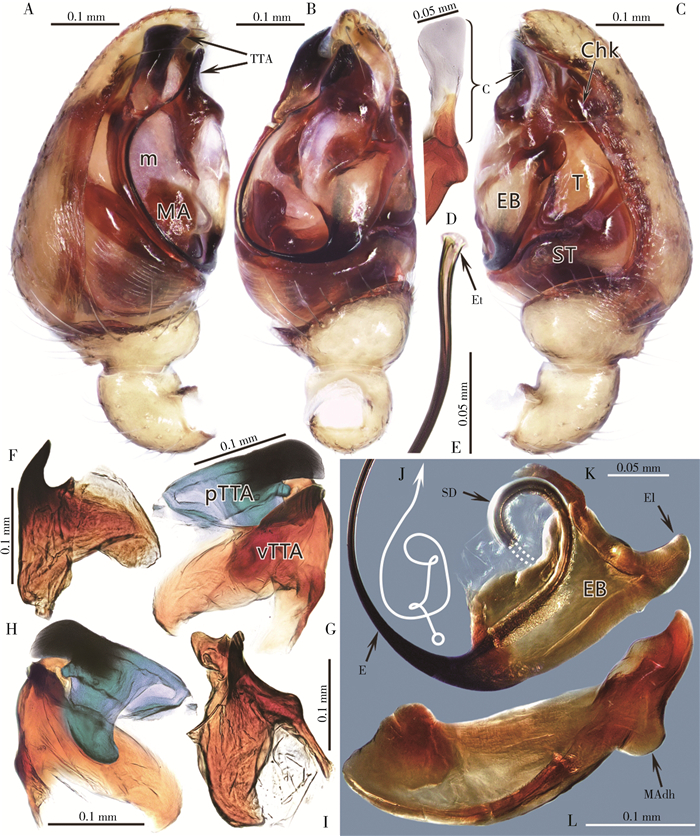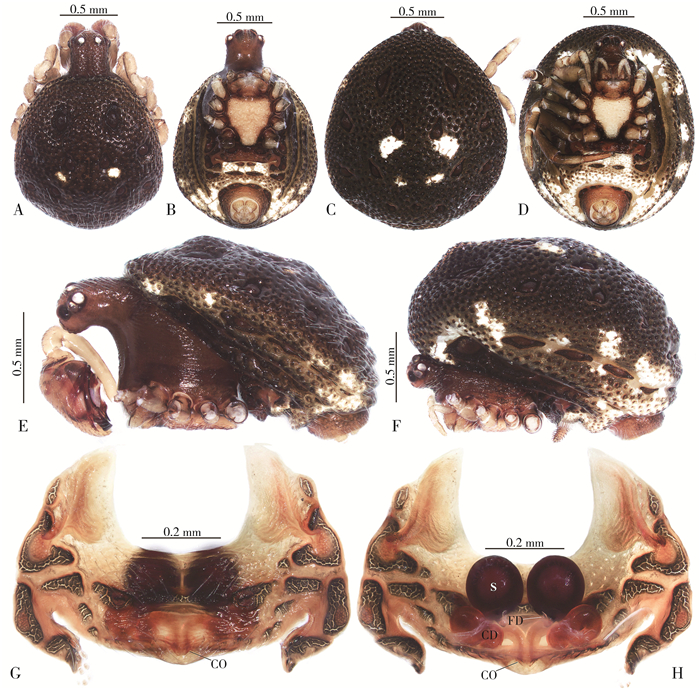扩展功能
文章信息
- 林子轩
- LIN Zixuan
- 瓢突头蛛的雄性新发现及其重描述
- Redescription of Phoroncidia crustula Zhu, 1998 with First Record of Male (Araneae: Theridiidae)
- 四川动物, 2021, 40(4): 431-437
- Sichuan Journal of Zoology, 2021, 40(4): 431-437
- 10.11984/j.issn.1000-7089.20200410
-
文章历史
- 收稿日期: 2020-10-28
- 接受日期: 2021-05-19
突头蛛属Phoroncidia Westwood, 1835是一类体长1.50~5.70 mm的小型球蛛,可通过其前突隆起的眼区,强角质化的腹部,及纺器周围具骨环等特征与球蛛科Theridiidae Sundevall, 1833其他属区分(Levi,1964)。通常生活于低矮灌木丛中,利用简单的带粘球单根丝线捕食飞虫。本属已知的80种广泛分布于除北美西部,欧洲温带地区和南北极以外的世界各地,半数以上的物种为单性描述,可能存在一些同物异名或疑难学名的情况,甚至有分科存疑的物种(Suzuki & Yokoi,2019),是亟待修订的类群。中国的突头蛛见于东洋界,目前已记述8种,4种仅提供了单性描述(World Spider Catalog,2020),其中瓢突头蛛P. crustula Zhu, 1998基于海南的1头雌性标本首次被描述(朱明生,1998)。2007年于云南西双版纳勐仑镇采集到2头雌性,扩充了本种的地理分布(Gao & Li,2014),但雄性仍未知。
笔者于2020年在海南尖峰岭国家森林公园进行标本采集时,利用振枝法收集到数头突头蛛,通过文献比对标本的外观、产地及生殖器结构等特征,鉴定为瓢突头蛛P. crustula Zhu, 1998。本文基于海南的标本对该种雌性作了重描述,首次报道了其雄性,并简要描述了其生活史。
文中长度测量数据单位为mm。外生殖器术语摘引自Agnarsson(2004)。标本均保存于中国科学院动物研究所(IZCAS)。
瓢突头蛛Phoroncidia crustula Zhu, 1998(图 1~图 3)

|
| 图 1 自然环境下的瓢突头蛛 Fig. 1 Phoroncidia crustula observed in the field A. 瓢突头蛛等待猎物的姿势, B~C. 瓢突头蛛捕食飞虫 A. P. crustula in the posture waiting for the prey, B-C. P. crustula foraging a fly |
| |

|
| 图 2 瓢突头蛛的雄性触肢 Fig. 2 Male palp of Phoroncidia crustula A. 触肢器前侧面观, B. 触肢器腹面观, C. 触肢器后侧面观, D. 引导器腹面观, E. 插入器末梢腹面观, F. 前侧盾片突腹面观, G. 盾片突腹面观, H. 盾片突背面观, I. 腹盾片突前侧面观, J. 输精管轨迹, K. 插入器腹面观, L. 中突后侧面观; C. 引导器, Chk. 跗舟侧突, E. 插入器, EB. 插入器基部, El. 插入器侧突, Et. 插入器末梢, m. 膜, MA. 中突, MAdh. 中突的背突, pTTA. 前侧盾片突, SD. 输精管, ST. 亚盾片, T. 盾片, TTA. 盾片突, vTTA. 腹盾片突 A. palp, prolateral view, B. palp, ventral view, C. palp, retrolateral view, D. conductor, ventral view, E. embolus tip, ventral view, F. prolateral tegular apophysis, ventral view, G. tegular apophysis, ventral view, H. tegular apophysis, dorsal view, I. ventral tegular apophysis, prolateral view, J. sperm duct trajectory, K. embolus, ventral view, L. median apophysis, retrolateral view; C. conductor, Chk. cymbial hook, E. embolus, EB. embolic base, El. embolus lobe, Et. embolus tip, m. membrane, MA. median apophysis, MAdh. dorsal hood of median apophysis, pTTA. prolateral tegular apophysis, SD. sperm duct, ST. subtegulum, T. tegulum, TTA. tegular apophysis, vTTA. ventral tegular apophysis |
| |

|
| 图 3 瓢突头蛛的身体外形和外雌器 Fig. 3 Body habitus and epigyne of Phoroncidia crustula A、B、E. 雄性外形, C、D、F. 雌性外形, G. 外雌器, H. 阴门, A、C、H. 背面观, B、D、G. 腹面观, E、F. 侧面观; CD. 交媾管, CO. 交媾孔, FD. 受精管, S. 纳精囊 A, B, E. male habitus, C, D, F. female habitus, G. epigyne, H. vulva, A, C, H. dorsal view, B, D, G. ventral view, E, F. lateral view; CD. copulatory duct, CO. copulatory orifice, FD. fertilization duct, S. spermathecae |
| |
Phoroncidia crustula Zhu, 1998: 29, figs. 12A-D
Phoroncidia crustula Song, Zhu & Chen, 1999: 127, figs. 66C-D
观察标本: 2 ♂ (IZCAS-Ar41826~Ar4 1827),1♀(IZCAS-Ar4 1828),海南省乐东黎族自治县尖峰岭国家森林公园鸣凤谷(108.845 8°E,18.743 2°N,海拔1 022 m),2020年7月17日,林子轩采;1♀(IZCAS-Ar4 1829),海南省乐东黎族自治县尖峰岭国家森林公园(108.882 1°E,18.677 8°N,海拔618 m),2020年7月13日,林子轩、莫云虎采;3♀(IZCAS-Ar41830~Ar4 1832),海南省乐东黎族自治县尖峰岭国家森林公园鸣凤谷(108.846 6°E,18.741 2°N,海拔1 000 m,2020年7月30日,林子轩采。
鉴别特征:瓢突头蛛与琉球突头蛛P. ryukyuensis (Yoshida,1979: 49,figs. 7~11)相似,表现为卵圆形腹部前缘具丘突;雌蛛背甲侧缘突出;纳精囊球形。但区别在于:前者腹部背突不明显;雄性触肢球盾片突脊具一背骨片,后者缺乏此特征;前者插入器基部具一侧突,而后者无侧突;前者外雌器交媾管直径约为纳精囊间距的5倍,后者交媾管直径与纳精囊间距几乎相等;前者交媾管轨迹比后者多1圈扭曲,位于纳精囊正下方。
描述:雄性(图 3:A、B、E)体长1.76。头胸部长1.16,宽0.84。腹部长1.69,宽1.36。背甲棕色,胸区色浅,头区隆起,两侧光滑,上方被刚毛,向前缘延伸至前中眼下方,刚毛基部具颗粒状微突。眼区较雌性更为前突,前、后眼列均后曲,后眼列稍长于前眼列,眼基具黑环。眼径:前中眼0.10,前侧眼0.07,后中眼0.07,后侧眼0.07;眼间距:前中眼间距0.05,前中侧眼间距0.02,后中眼间距0.10,后中侧眼间距0.05,中眼区长0.21,前边长0.22,后边长0.24。额高约为前中眼直径的4倍。螯肢棕色,短小,前齿堤具2大齿,后齿堤无齿。颚叶、下唇均为棕色。胸板黄色,近心形,表面具不规则龟裂纹。步足短粗,黄色。步足测量:Ⅰ 1.45(0.50、0.49、0.21、0.25),Ⅱ 1.44(0.49、0.47、0.21、0.27),Ⅲ 1.02(0.32、0.34、0.15、0.21),Ⅳ 1.75(0.54、0.62、0.29、0.30)。足式:4,1,2,3。腹部略小于雌性,卵圆形,强角质化,前方突出并覆盖胸区。背面深棕色,具若干对称的印痕,前缘具一丘突,不明显;正中央微隆起,隆起两旁具1对白斑。腹侧对称分布白斑。腹面具对称印痕,纺器围有棕色骨环,周围具大片白斑。无舌状体。
触肢器(图 2:A~L):胫节碗状。跗舟远端渐细,顶端略分叉。跗舟侧突钩状,末端尖且向上。引导器基部角质化,与盾片融合,约占其1/3长;引导器端部透明、膜质,约占其2/3长。插入器基部具一指状侧突,位于引导器基部下方;插入器长、细线状。中突前侧面部分扁平,向触肢球中部弯曲;中突具一远背突。盾片突由2个可活动骨片构成;前侧盾片突末端斜指向跗舟远端,具一亚突;腹盾片突具脊痕,背部具一骨片附着。
雌性(图 3:C、D、F):体长2.07。头胸部长1.06,宽0.80。腹部长1.85,宽1.69。前中眼0.09,前侧眼0.07,后中眼0.07,后侧眼0.07;眼间距:前中眼间距0.04,前中侧眼间距0.02,后中眼间距0.09,后中侧眼间距0.04,中眼区长0.21,前边长0.19,后边长0.21。步足测量:Ⅰ 1.40(0.47、0.50、0.21、0.22),Ⅱ 1.32(0.44、0.42、0.20、0.26),Ⅲ 1.27(0.39、0.42、0.20、0.26),Ⅳ 1.92(0.65、0.67、0.30、0.30)。足式:4,1,2,3。雌雄蛛外形基本相似,以下几点除外:雌蛛头区隆起和前突程度较雄蛛小;雌蛛背甲基部侧缘突出,形似两肩;雌蛛头区上方光滑,两边具刚毛,延伸至眼区;雌蛛胸板龟裂刻纹弱;雌蛛腹部大于雄蛛,背面具前大后小的2对白斑。
外雌器(图 3:G、H):腹面观:外雌器生殖板强角质化,1枚条状印痕位于2枚左右对称的眼状印痕之间。交媾孔窄小。交媾管长且弯曲,连接纳精囊底部。纳精囊圆球形,间距小。受精管短小呈钩状,末端内弯向中部。
分布:中国(海南、云南)。
生活史:本次对瓢突头蛛织网行为的观察,与Marples(1955)记录的突头蛛网型中最简单的一类相仿:带粘球的平直单根丝线(图 1:A)。但从细节上分析,完整的构造由2条独立的丝段构成:蜘蛛后方的丝段(不具粘性,被1条步足Ⅳ的爪钩住,一端连接树叶,另一端连接蜘蛛的纺器,因此可抽丝增加该段长度);蜘蛛前方的丝段(长数10 cm,带有粘球,一端被蜘蛛用1条步足Ⅰ的爪钩住,另一端连接远处的树叶)。当猎物被捕获时,蜘蛛会抽丝增长后方的丝段,使原本平直的单丝呈现“V”形;之后用步足收紧前方带粘球的丝段,直至能触碰到猎物;随即调转身体,用2条步足Ⅳ交替运动,纺丝包裹住猎物。图 1(B、C)中被瓢突头蛛捕食的飞虫隶属于双翅目Diptera长角亚目Nematocera,被粘住了步足。
对于园蛛总科Araneoidea Latreille, 1806的蜘蛛,简化的网可能会带来复杂的捕食策略。突头蛛可能利用异种信息素捕食猎物的观点最初由Eberhard(1981)提出,发现P. studo Levi, 1964的粘球蛛丝对雄性迟眼蕈蚊Bradysia sp.的吸引力似乎具有特异性,他认为这种现象暗示了突头蛛的化学拟态。突头蛛是否能够释放模拟性信息素诱捕猎物,目前仍缺乏行为学和分析化学证据,有待深入研究。
致谢: 感谢林业杰(中国科学院动物研究所)帮助申请标本编号和对本文提出的修改建议。感谢王成(铜仁学院农林工程与规划学院)赠予胰蛋白酶溶液支持此研究。感谢莫云虎在标本采集过程中协助。
朱明生. 1998. 中国动物志 蛛形纲 蜘蛛目 球蛛科[M]. 北京: 科学出版社.
|
Agnarsson I. 2004. Morphological phylogeny of cobweb spiders and their relatives (Araneae, Araneoidea, Theridiidae)[J]. Zoological Journal of the Linnean Society, 141(4): 447-626. |
Eberhard WG. 1981. The single line web of Phoroncidia studo Levi (Araneae: Theridiidae): a prey attractant?[J]. Journal of Arachnology, 9: 229-232. |
Gao CX, Li SQ. 2014. Comb-footed spiders (Araneae: Theridiidae) in the tropical rainforest of Xishuangbanna, Southwest China[J]. Zoological Systematics, 39(1): 1-135. |
Levi HW. 1964. American spiders of the genus Phoroncidia (Araneae: Theridiidae)[J]. Bulletin of the Museum of Comparative Zoology, 131: 65-86. |
Marples BJ. 1955. A new type of web spun by spiders of the genus Ulesanis with the description of two new species[J]. Proceedings of the Zoological Society of London, 125: 751-760. |
Song DX, Zhu MS, Chen J. 1999. The spider of China[M]. Shijiazhuang: Hebei Science and Technology Publishing House.
|
Suzuki Y, Yokoi T. 2019. Discovery of the web of Phoroncidia altiventris (Araneae: Theridiidae) and implications for its taxonomic position[J]. Acta Arachnologica, 68(1): 31-33. DOI:10.2476/asjaa.68.31 |
World Spider Catalog. 2020. World spider catalog. Version 21.5[EB/OL]. [2020-10-24]. http://wsc.nmbe.ch.
|
Yoshida H. 1979. Notes on the Japanese species of the genus Phoroncidia (Araneae: Theridiidae)[J]. Acta Arachnologica, 28: 45-51. DOI:10.2476/asjaa.28.45 |
 2021, Vol. 40
2021, Vol. 40




